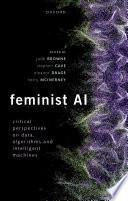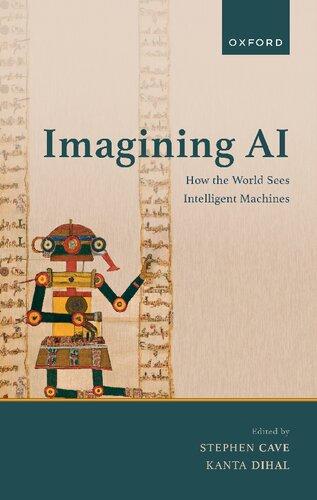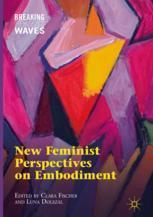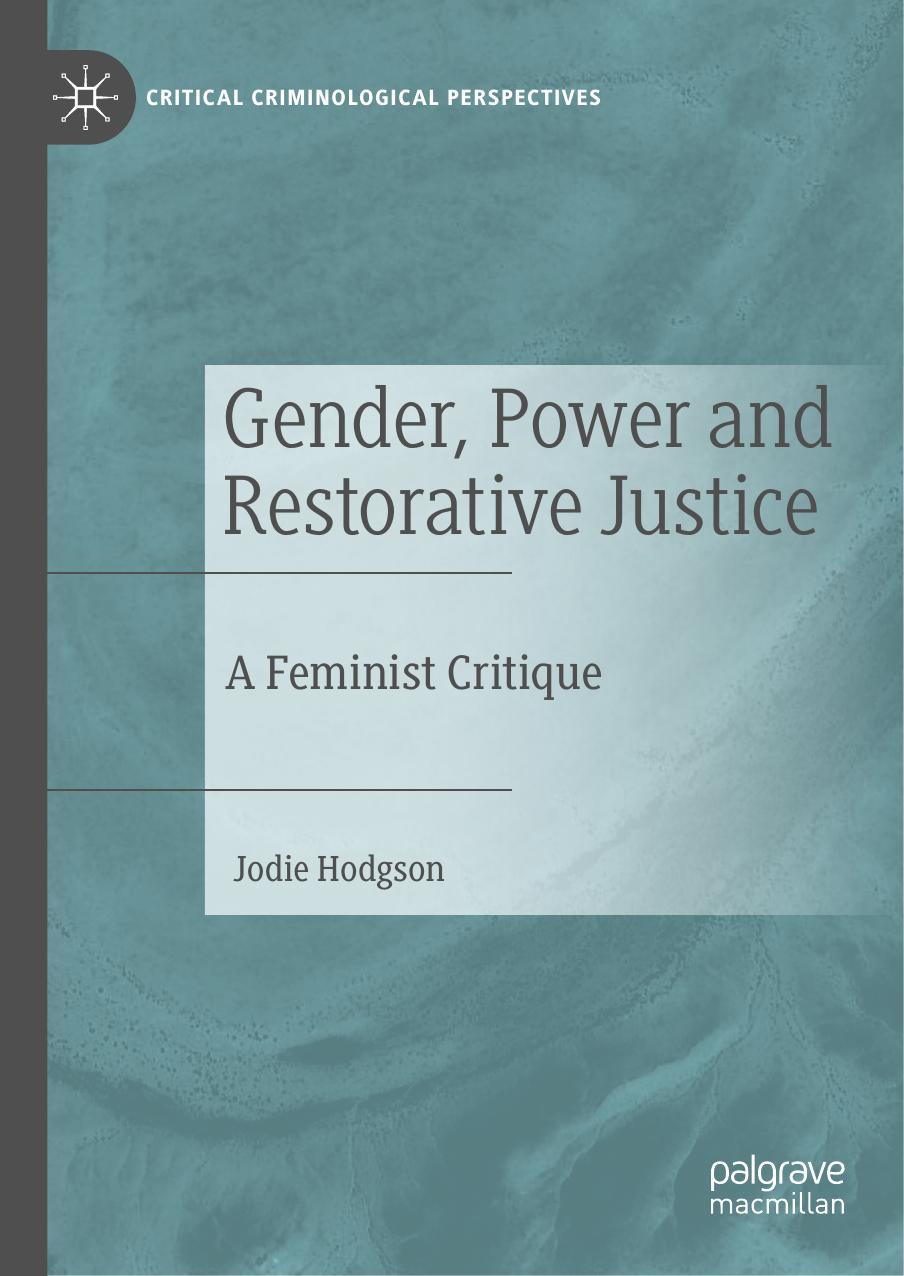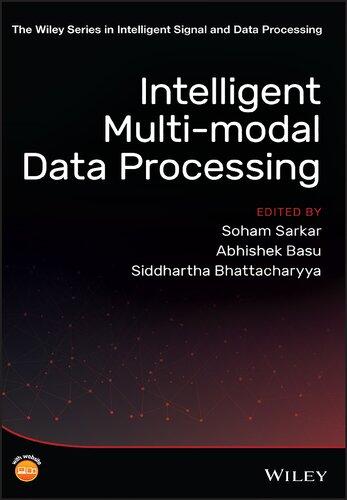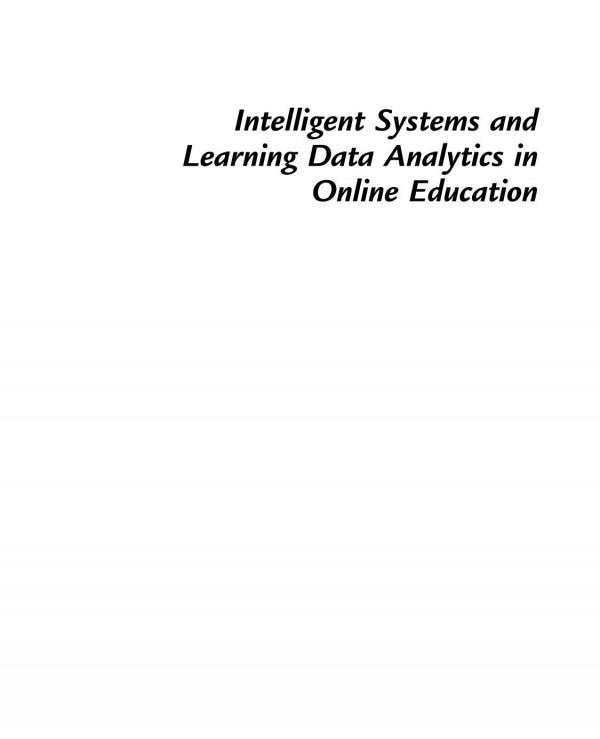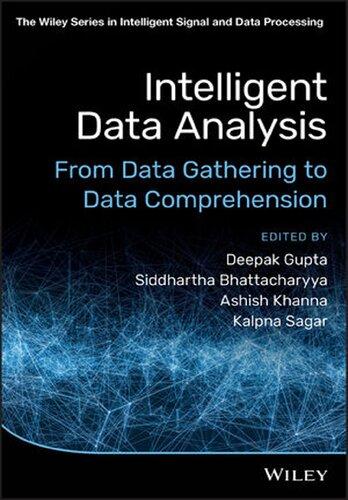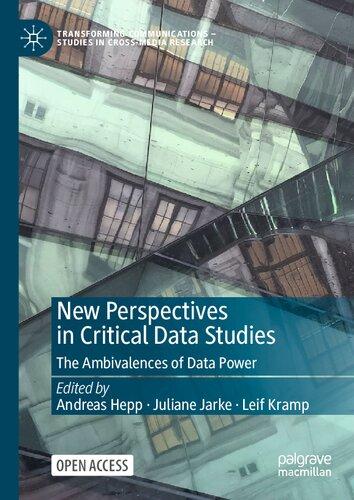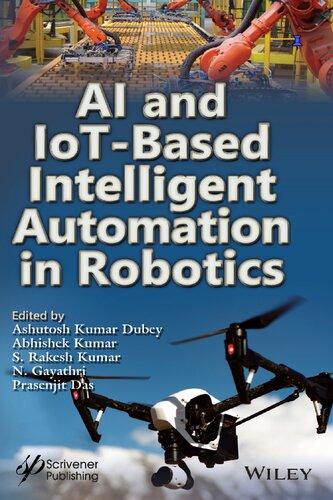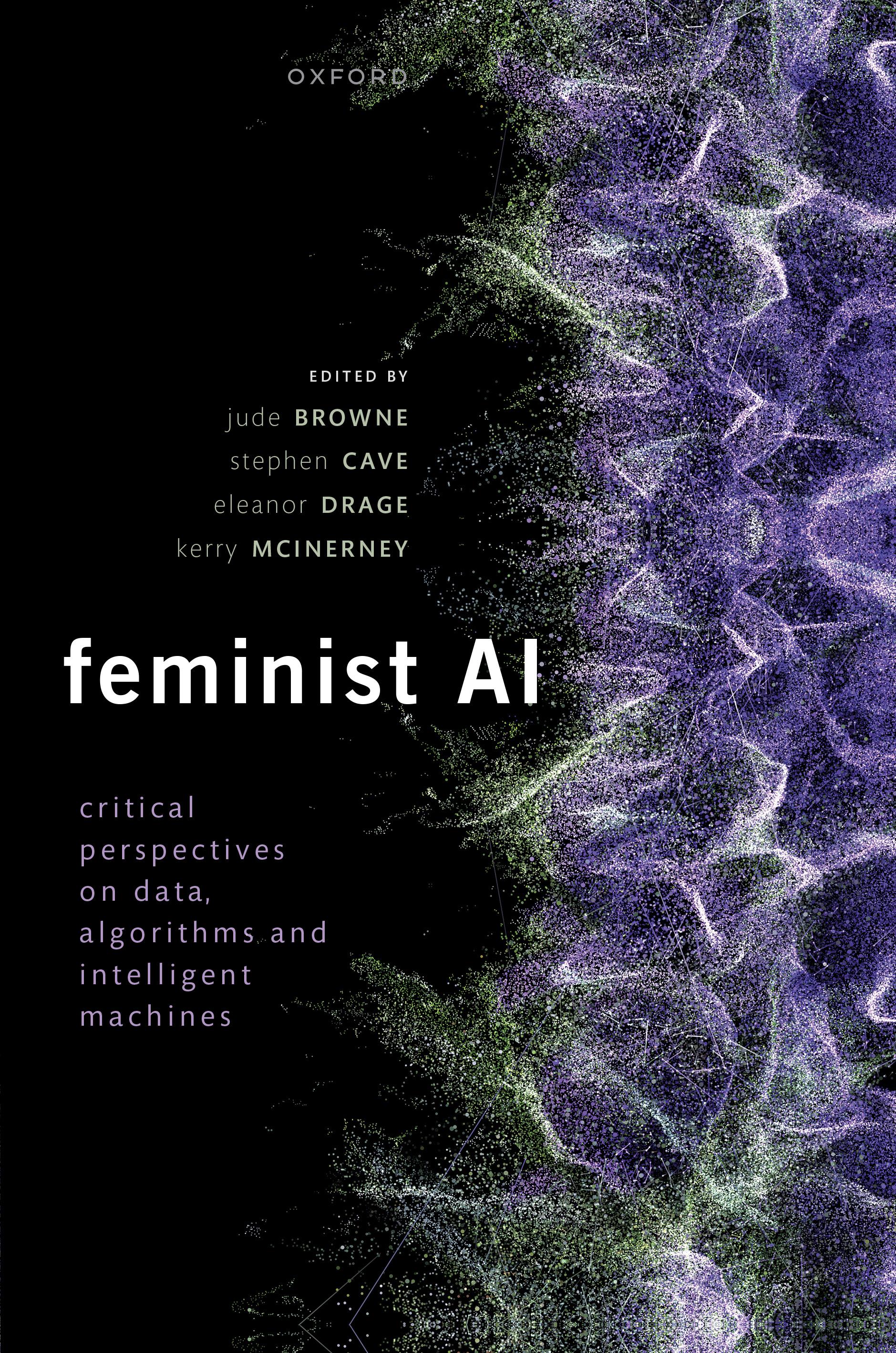Algorithms, Data, and Intelligent Machines Jude Browne Visit to download the full and correct content document: https://ebookmass.com/product/feminist-ai-critical-perspectives-on-algorithms-data-an d-intelligent-machines-jude-browne/
More products digital (pdf, epub, mobi) instant download maybe you interests ...
Imagining AI: How the World Sees Intelligent Machines
Stephen Cave
https://ebookmass.com/product/imagining-ai-how-the-world-seesintelligent-machines-stephen-cave/
New Feminist Perspectives on Embodiment 1st Edition
Clara Fischer
https://ebookmass.com/product/new-feminist-perspectives-onembodiment-1st-edition-clara-fischer/
Critical Criminological Perspectives Jodie Hodgson
Gender Power And Restorative Justice A Feminist
Critique Palgrave Macmillan 2022 Desconocido
https://ebookmass.com/product/critical-criminologicalperspectives-jodie-hodgson-gender-power-and-restorative-justicea-feminist-critique-palgrave-macmillan-2022-desconocido/
Intelligent Multi-Modal Data Processing (The Wiley Series in Intelligent Signal and Data Processing) 1st Edition Soham Sarkar
https://ebookmass.com/product/intelligent-multi-modal-dataprocessing-the-wiley-series-in-intelligent-signal-and-dataprocessing-1st-edition-soham-sarkar/
Intelligent Systems and Learning Data Analytics in Online Education: A volume in Intelligent Data-Centric Systems Santi Caballé
https://ebookmass.com/product/intelligent-systems-and-learningdata-analytics-in-online-education-a-volume-in-intelligent-datacentric-systems-santi-caballe/
Intelligent Data Analysis: From Data Gathering to Data Comprehension Deepak Gupta
https://ebookmass.com/product/intelligent-data-analysis-fromdata-gathering-to-data-comprehension-deepak-gupta/
New Perspectives In Critical Data Studies: The Ambivalences Of Data Power 1st Edition Andreas Hepp
https://ebookmass.com/product/new-perspectives-in-critical-datastudies-the-ambivalences-of-data-power-1st-edition-andreas-hepp/
AI and IoT-Based Intelligent Automation in Robotics Ashutosh Kumar Dubey
https://ebookmass.com/product/ai-and-iot-based-intelligentautomation-in-robotics-ashutosh-kumar-dubey/
Mental Health in Prisons: Critical Perspectives on Treatment and Confinement 1st ed. Edition Alice Mills
https://ebookmass.com/product/mental-health-in-prisons-criticalperspectives-on-treatment-and-confinement-1st-ed-edition-alicemills/
FeministAI FeministAI CriticalPerspectivesonData,Algorithmsand IntelligentMachines Editedby
PROFESSORJUDEBROWNE HeadofDepartment,DepartmentofPoliticsandInternationalStudies, UniversityofCambridge
FrankopanDirectorattheUniversityofCambridgeCentreforGenderStudies
DRSTEPHENCAVE DirectoroftheInstituteforTechnologyandHumanity,Universityof Cambridge.
DRELEANORDRAGE ChristinaGawPost-DoctoralResearchAssociateinGenderandTechnology, UniversityofCambridgeCentreforGenderStudies,SeniorResearchFellowat theLeverhulmeCentrefortheFutureofIntelligence
DRKERRYMCINERNEY ChristinaGawPost-DoctoralResearchAssociateinGenderandTechnology, UniversityofCambridgeCentreforGenderStudies,ResearchFellowatthe LeverhulmeCentrefortheFutureofIntelligence
GreatClarendonStreet,Oxford,OX26DP, UnitedKingdom
OxfordUniversityPressisadepartmentoftheUniversityofOxford. ItfurtherstheUniversity’sobjectiveofexcellenceinresearch,scholarship, andeducationbypublishingworldwide.Oxfordisaregisteredtrademarkof OxfordUniversityPressintheUKandincertainothercountries ©OxfordUniversityPress2023
Themoralrightsoftheauthorshavebeenasserted Allrightsreserved.Nopartofthispublicationmaybereproduced,storedin aretrievalsystem,ortransmitted,inanyformorbyanymeans,withoutthe priorpermissioninwritingofOxfordUniversityPress,orasexpresslypermitted bylaw,bylicenceorundertermsagreedwiththeappropriatereprographics rightsorganization.Enquiriesconcerningreproductionoutsidethescopeofthe aboveshouldbesenttotheRightsDepartment,OxfordUniversityPress,atthe addressabove
Chapter5,‘ShuriintheSeaofDudes’,Chapter12,‘TheFalseBinaryofReasonandEmotioninData Visualisation’,andChapter18,‘DigitalAgeism,AlgorithmicBias,andFeministCriticalTheory’areavailable onlineanddistributedunderthetermsofaCreativeCommonsAttribution–NonCommercial–No Derivatives4.0Internationallicence(CCBY-NC-ND4.0),acopyofwhichisavailableat http:// creativecommons.org/licenses/by-nc-nd/4.0/
Youmustnotcirculatethisworkinanyotherform andyoumustimposethissameconditiononanyacquirer PublishedintheUnitedStatesofAmericabyOxfordUniversityPress 198MadisonAvenue,NewYork,NY10016,UnitedStatesofAmerica
BritishLibraryCataloguinginPublicationData Dataavailable
LibraryofCongressControlNumber:2023934461
ISBN978–0–19–288989–8
DOI:10.1093/oso/9780192889898.001.0001
Printedandboundby CPIGroup(UK)Ltd,Croydon,CR04YY LinkstothirdpartywebsitesareprovidedbyOxfordingoodfaithand forinformationonly.Oxforddisclaimsanyresponsibilityforthematerials containedinanythirdpartywebsitereferencedinthiswork.
Acknowledgements Wearegratefultoourgenerousfunder,ChristinaGaw,whomadethisproject possible.Shewrites:
Wearegoingthroughinterestingtimes,whenhumansarealwayslookingforways tomakeourworldabetterplace,andtopositivelyimpactourcommunities.ExcitingdevelopmentsinAIwillcontributetothemanyconveniencesofthisnew world:ensuringthatAIisdevelopedinagenderanddiversityinclusivemanner rightfromthestartiskeytoitssuccessfulimplementationandwillmakeour futureworldamuchmoreequitableone.
WearealsogratefulforthesupportoftheLeverhulmeTrustthroughtheLeverhulmeCentrefortheFutureofIntelligence.
Wewouldalsoliketogivespecialthankstoallofourcontributorsfortheirexcellentessaysandtheirenthusiasmforthisproject,andinparticulartoOsKeyes,who providedextraeditorialfeedbackonanumberofchapters.ManythankstoGiulia LippariniandSonkeAdlungatOxfordUniversityPressfortheirinvaluablesupportthroughoutthepublicationprocess,andtotheanonymouspeerreviewersfor theirinsightfulcommentsandsuggestions.
Finally,wewouldliketoextendourheartfeltthankstoourresearchassistant,YoungchoLee,whoseworkhasbeenfundamentaltothecompletionofthis volume.
Contents ContributorAffiliations viii
Introduction:FeministAI xii JudeBrowne,StephenCave,EleanorDrage,andKerry McInerney
1.Technosymbiosis:Figuring(Out)OurRelationstoAI 1 N.KatherineHayles
2.MakingKinwiththeMachines 19 JasonEdwardLewis,NoelaniArista,ArcherPechawis,and SuzanneKite
3.AIinaDifferentVoice:RethinkingComputers,Learning, andGenderDifferenceatMITinthe1980s 32 ApollineTaillandier
4.FeminismConfrontsAI:TheGenderRelationsof Digitalisation 47 JudyWajcmanandErinYoung
5.ShuriintheSeaofDudes:TheCulturalConstructionof theAIEngineerinPopularFilm,1920–2020 65 StephenCave,KantaDihal,EleanorDrage,andKerry McInerney
6.NoHumansintheLoop:KillerRobots,Race,andAI 83 LaurenWilcox
7.Coding‘CarnalKnowledge’intoCarceralSystems:A FeministAbolitionistApproachtoPredictivePolicing 101 KerryMcInerney
8.Techno-RacialCapitalism:ADecolonialBlackFeminist MarxistPerspective 119 LeliaMarieHampton
9.FeministTechnofutures:ContestingtheEthicsandPolitics ofSexRobotsandAI 137 NedaAtanasoski
10.FromELIZAtoAlexa:AutomatedCareLabourandthe
SareetaAmrute
12.TheFalseBinaryofReasonandEmotioninData Visualisation
CatherineD’IgnazioandLaurenKlein
13.PhysiognomyintheAgeofAI
BlaiseAgu¨erayArcas,MargaretMitchell,andAlexander Todorov
14.SignsTakenforWonders:AI,Art,andtheMatterofRace
16.AIthatMatters:AFeministApproachtotheStudyof IntelligentMachines
18.DigitalAgeism,AlgorithmicBias,andFeministCritical Theory
RuneNyrup,CharleneH.Chu,andElenaFalco 19.AIandStructuralInjustice:AFeministPerspective
21.DesignPractices:‘NothingAboutUsWithoutUs’
SashaCostanza-Chock
ContributorAffiliations GarnettAchieng isatechnologyresearcherbasedinEastAfrica.Garnettresearchesand consultsondataanddigitalrights,digitalfeministactivism,technologyfacilitatedVAW, onlineharms,platformgovernance,opensourceadvocacy,anddigitalcultures.
BlaiseAguerayArcas isaPrincipalScientistatGoogle,whereheleadsateamworkingon machineintelligenceformobiledevices.Blaisehasworkedonaugmentedreality,mapping, wearablecomputing,andnaturaluserinterfaces.
SareetaAmrute isanAffiliateAssociateProfessorofAnthropologyattheUniversityof WashingtonwhostudiestheproductionofraceandclassinUSandEUprogramming economies,andthatoffinancialgoodthroughdata-centrictechnologiesinIndia.
NoelaniArista isanAssociateProfessorintheHistoryandClassicalStudiesDepartment andtheDirectoroftheIndigenousStudiesProgramatMcGillUniversity.Noelani’sresearch appliesartificialintelligenceandmachinelearningtoHawaiianlanguagesources.
NedaAtanasoski isanAssociateProfessoroffeministstudiesattheUniversityofMaryland,CollegePark.Neda’sresearchinterestsincludeculturalstudiesandcriticaltheory; warandnationalism;gender,ethnicity,andreligion.
CarolineBassett isaProfessorofDigitalHumanitiesattheFacultyofEnglishoftheUniversityofCambridge.Carolineexploresdigitaltechnologiesinrelationtoquestionsof knowledgeproductionandepistemologyandculturalforms,practices,andwaysofbeing.
JudeBrowne istheFrankopanDirectorattheUniversityofCambridgeCentreforGenderStudies,HeadofDepartmentofPoliticsandInternationalStudiesandaFellowof King'sCollege,UniversityofCambridge.Juderesearchesgender,politicaltheoriesofequality,publicpolicy,politicalresponsibility,structuralinjusticeandrights,andtheimpactof technologyonsociety.
StephenCave istheExecutiveDirectorofInstituteforTechnologyandHumanity,UniversityofCambridgeandSeniorResearchAssociateintheFacultyofPhilosophyof theUniversityofCambridge.Stephen’sresearchinterestscurrentlyfocusonthenature, portrayal,andgovernanceofAI.
ChenaiChair isadigitalpolicyandgenderexpertofMyDataRightsAfricawithextensive experienceinworkthatisfocusedonunderstandingtheimpactoftechnologyinsocietyin ordertobetterpublicinterestinpolicy.
SashaCostanza-Chock isaresearcheranddesignerwhoworkstosupportcommunityledprocessesthatbuildsharedpower,dismantlethematrixofdomination,andadvance ecologicalsurvival.
CharleneChu isanAssistantProfessorattheLawrenceS.BloombergFacultyofNursingat theUniversityofToronto,Charlene’sprimaryareaofresearchisindesigninginterventions thatsupportthemobilityanddailyfunctionofolderadultsinpost-acutecaresettings.
ElenaFalso isaPhDstudentattheDepartmentofScienceandTechnologyStudiesatUCL andworksasaresearchassistantattheCentreforFutureIntelligenceattheUniversityof Cambridge.
CatherineD’Ignazio isanAssistantProfessorofUrbanScienceandPlanninginthe DepartmentofUrbanStudiesandPlanningatMIT.Catherineisascholar,artist/designer andhackerwhofocusesonfeministtechnology,dataliteracy,andcivicengagement.
NeemaIyer isthefounderofacivictechnologycompany,Pollicy,basedinKampala, Uganda.Sheisanactivedo-erandspeakerondata,digitalrightsandbuildingproducts toimproveservicedelivery.Sheisalsoanartist,bothdigitallyandintherealworld.
LaurenKlein isanassociateprofessorintheDepartmentsofEnglishandQuantitativeTheory&MethodsatEmoryUniversity.Laurenresearchinterestsincludedigital humanities,datascience,datastudies,andearlyAmericanliterature.
KantaDihal isaSeniorResearchFellowattheLeverhulmeCentrefortheFutureofIntelligence.Kantaresearchinterestsincludeliteratureandscience,sciencefiction,modernism, postmodernism,andpostcolonial,decolonial,andcriticalracetheory.
EleanorDrage isaChristinaGawPost-DoctoralResearchAssociateinGenderandTechnologyattheUniversityofCambridgeCentreforGenderStudies.Eleanorresearches feminist,anti-racist,post-humanist,andqueerapproachestotechnologicalprocessesand systems.
MicheleElam isaProfessorofHumanitiesintheEnglishDepartmentatStanfordUniversity.Elam’sresearchininterdisciplinaryhumanitiesconnectsliteratureandthesocial sciencesinordertoexaminechangingculturalinterpretationsofgenderandrace.
FedericaFrabetti isaPrincipalLecturerinDigitalMediaandHeadofPartnershipsat theUniversityofRoehampton.Federicaisinterestedinthecultureandphilosophyof technology,digitalmedia,softwarestudies,culturaltheory,andgenderandqueertheory.
LeliaMarieHampton isaPhDstudentinComputerScienceattheMIT.Lelia’sresearch interestsareAIandethics,AIsafety,computationalsocialscience,computationalsustainability,human-centredAI,anduserexperienceofmarginalisedgroups.
N.KatherineHayles isDistinguishedResearchProfessorofEnglishatUCLAandthe JamesB.DukeProfessorofLiteratureEmeritaatDukeUniversity.Katherineteaches
andwritesontherelationsofliterature,science,andtechnologyinthetwentiethand twenty-firstcenturies.
OsKeyes isaPhDstudentattheUniversityofWashington’sDepartmentofHumanCentredDesign&Engineering.Osstudiesgender,disability,technology,and/orpower,and theroletechnologyplaysinconstructingtheworld.
SuzanneKite isaperformanceartist,visualartist,andcomposerraisedinSouthernCalifornia,withaBFAfromCalArtsinmusiccomposition,anMFAfromBardCollege’sMilton AveryGraduateSchool,andisaPhDstudentatConcordiaUniversity.
JasonEdwardLewis isaProfessorofComputationArts,Design,andComputationArtsat ConcordiaUniversityandadigitalmediaartist,poetandsoftwaredesigner.Jasonfounded ObxLaboratoryforExperimentalMediaanddirectstheInitiativeforIndigenousFutures.
KerryMcInerney isaChristinaGawPost-DoctoralResearchAssociateinGenderand TechnologyattheUniversityofCambridgeCentreforGenderStudies.Kerryresearches howhistoriesofgenderedandracialisedviolencemanifestinnewandemergingtechnologies.
MargaretMitchell isanAIResearchScientistworkingonethicalAI,currentlyfocusedon theinsandoutsofethics-informedAIdevelopmentintech.Margaretpreviouslyworkedat GoogleAIasaStaffResearchScientist,whereshefoundedandco-ledtheEthicalAIgroup.
RuneNyrup isaSeniorResearchFellowontheScience,Value,andtheFutureofIntelligenceproject.AttheCFI,Runeisexploringtheseissuesinrelationtoartificialintelligence, bothasafieldofresearchandasatechnology.
ArcherPechawis isanAssistantProfessorofVisualArt&ArtHistoryatYorkUniversity. Archerisaperformance,theatreandnewmediaartist,filmmaker,writer,curator,and educator.
JenniferRhee isanAssociateProfessorattheVirginiaCommonwealthUniversity.Jennifer’sresearchfocusesonliterature,technologyandscience,contemporaryAmerican literature,mediastudies,roboticsandartificialintelligence,anddigitalart.
ApollineTaillandier isapostdoctoralresearchassociateatPOLISandtheLeverhulme CentrefortheFutureofIntelligenceattheUniversityofCambridge,andattheCenterfor ScienceandThoughtattheUniversityofBonn.
AlexanderTodorov isaProfessorofBehavioralScienceattheUniversityofChicagoBooth SchoolofBusiness.Alexanderstudieshowpeopleperceive,evaluate,andmakesenseofthe socialworld.
JudyWajcman isaProfessorofSociologyatLSEandaFellowattheAlanTuringInstitute. Judy’sscholarlyinterestsencompassthesociologyofworkandemployment,scienceand technologystudies,gendertheory,temporality,andorganisationalanalysis.
LaurenWilcox istheDirectoroftheUniversityofCambridgeCentreforGenderStudies. Lauren’sresearchinvestigatestheconsequencesforthinkingaboutbodiesandembodiment inthestudyofinternationalpracticeofviolenceandsecurity.
ErinYoung isapostdoctoralresearchfellowattheAlanTuringInstituteontheWomenin DataScienceandAIproject,withinthePublicPolicyprogramme.
Introduction:FeministAI JudeBrowne,StephenCave,EleanorDrage,andKerryMcInerney
Recentyearshaveseenbothanexplosioninartificialintelligence(AI)systems andacorrespondingriseinimportantcriticalanalysesofsuchtechnologies.Centraltothiscriticalanalysishasbeenfeministscholarship,whichhasheldtheAI sectoraccountablefordesigninganddeployingAIinwaysthatfurther,rather thanundermine,thepursuitofsocialjustice. FeministAI bringsfeministtheory, knowledge,methods,andepistemologiestointerrogatehowAIcanexacerbate, reproduce,andsometimeschallengeexistinginequalitiesandrelationsofpower. Ouraimistodemonstratehowfeministscholarshipprovidesessentialinsights intoAI’ssocialandpoliticalimpact,rangingfromtheoppressiveimplicationsof facialrecognitiontechnologiesthroughtopoliticalapproachestoAI-generated harm.
ThisisthefirstanthologyspecificallyfocusingonfeministworkinAI.Itbrings togethernewworkwithkeytextsfrombothestablishedandemergingvoicesin thefield.Thecriticalconversationthatensuesreflectslonghistoriesoffeminist thinkingonthemesincludingscience,technology,labour,capitalism,care,violence,representation,justice,andexclusion.Thecontributorstothisvolumeare alreadyplayingaleadingroleinshapingcontemporarydebatesaround‘intelligentmachines’,andforgingnewdirectionsinthefield.Theinterplaybetweenthis volumes’chaptersilluminateskeyfeministconcernssuchas:CanAIbefeminist? Whomakestechnologyandforwhom?Whenandhowshouldfeministsresist newandemergingAI-poweredtechnologies?HowdothegenderedeffectsofAI intersectwithotherformsofpowerandcontrol,suchasethnicity,race,class,disability,sexuality,andage?Howarefeministmovementscurrentlyusingdataand forwhatends?CanAIinfersexuality?WhatidentitiesdoesAIproduce?What wouldaqueertechnologicalfuturelooklike?Howmightwebegintolookpast theliabilitygeneratedbyAItoalsoconsideritsmuchwiderstructuraldynamics? Thesequestionssimultaneouslygesturetowardsthenewchallengesforfeminist activismposedbyemergingtechnologiesaswellastheproblematiccontinuities feministshavefacedacrosstimesandspaces.
Thisvolumebringstogetherscholarsfromawidevarietyofdisciplinarybackgrounds,fromcomputerscience,softwareengineering,andmedicalsciences tosociology,politicaltheory,anthropology,andliterature.Contributorsbring interdisciplinaryfeministinsightsfromdisciplinesincludingpostcolonialstudies,disabilitytheory,andBlackMarxisttheorytoconfrontageism,racism,sexism,
ableism,andclass-basedoppressionsinAI.Thiscollectionalsoreflectstheincreasinglyblurreddividebetweenacademiaandindustrywheninconversationonthe risksandpossibilitiesthatarisewhenadoptingAI.
ThisbookhasemergedfromtheGenderandTechnologyProjectattheUniversityofCambridge,acollaborationbetweentheUniversityofCambridgeCentre forGenderStudiesandtheLeverhulmeCentrefortheFutureofIntelligence. Whileallfourmembersoftheeditorialteamspecialiseintheintersectionoffeministtheoryandtechnologystudies,wearecognizantofthelimitationsofour currentlysharedlocationandthepartialperspectivethisnecessarilygrantsusas editors,educators,andscholars.Threeoutoffourofoureditorialteamidentify aswhite,andallfourofusarebasedintheGlobalNorth.Furthermore,manyof ourcontributorsarepresentlylocatedintheGlobalNorth,evenastheyoccupy differentstructuralrelations,identitycategories,andpositionalitieswithintheir respectiveinstitutionsandsocieties.Weinvitereaderstoconsiderhowandwhy, currentlyatleast,feministworkinAIisheavilyweightedtowardsthesespaces.We donotaimforthistexttobethedefinitiveguidetofeministAI,butrathertobegin tohighlighttheimportanceoffeministanalysesinthisarena.
Thiscollectionbeginswithanewessayby N.KatherineHayles,oneofthe foundationalthinkersinfeministSTS(scienceandtechnologystudies).Inthis essay,‘Technosymbiosis:Figuring(Out)OurRelationstoAI’,HaylesturnstocreatingabettermetaphorwithwhichtodescribetherelationshipbetweenAIand itsenvironment.Thisisofutmostimportancetothefeministagenda.AsDonna Harawayhasargued,wedonot‘resort’tometaphorbutengageinwor(l)dingpracticesthroughourre-figuringofkeyconcepts.Haylesarguesthatthemetaphor of‘technosymbiosis’isappropriateforthistask,becauseitconnectstheexistenceofincreasinglypowerfulcomputationalmediatoenvironmentalcriseswhile combatinganthropocentristperspectivesonagencyandintelligence.Sheusesthe concepttoarguethatmeaning-makingisnotonlyahumanactivity,because machinesalsocreateandconveymeaningincomputationalprocesseswithor withoutahuman‘intheloop’.
Decenteringanthropocentrisminthewaywethinkhumanandmachinecoexistenceisalsothefoundationalmessageof JasonEdwardLewis,Noelani Arista,ArcherPechawis,andSuzanneKite’s ‘MakingKinwiththeMachines’. Infact,theauthorsarguethatheterogeneousindigenousperspectivesarethe bestwayofapproachingAI’s‘circleofrelationships’betweenhumanandnonhumanactors.WhereAIdesignisoften‘human-centred’,thisessayradically refusestheideaofaseparatehumanspecieswhoseprioritiestrumpthatofits environment.Instead,itemphasisesreciprocalandrespectfulinterspeciesrelationships.Indoingso,itholdsfeminismtoitspledgetocontestextractivecapitalist logicbyre-framingAIas‘ĀIna’,aslandbutnotterritory,asthatwhichsustains us.WhereWesternoriginstoriesfortechnologyoftendrawonPrometheus,the authorsdemonstratehowtalesfromthePacificOceansuchas‘Hāloa’canforma
moreethical‘operatingcode’for maoli (human)–AIrelations.Theessaycontests theindustry’semphasisonunfetteredgrowthandscalabilitybyurgingfor‘good growth’basedonprinciplesfromKānakaMaoligovernance.
ApollineTaillandier’sessay‘AIinaDifferentVoice:RethinkingComputers, Learning,andGenderDifferenceatMITinthe1980s’demonstrateshowthere havebeenotherattemptsinthepasttocreateAI-poweredsystemsthatreimagine AIthroughafeministlens.Taillandierdocumentsthecreationoftheprogramming language‘Logo’,developedinthe1960asanalternativewayofteachingconcepts inmathematicsandcomputerscience.Significantly,whendesigningLogo,programmersturnedtofeministknowledgetorethinkcrucialaspectsofAI.They redefinedthedesirablefeaturesofcomputercultureandtheidealprofileofthe computerscientist;theyovercamedivisionsbetweenthehumanitiesandthesciencesandbetweensensoryandintellectualexploration;andtheyemphasisedthat computerlanguagesandcodingculturearealwayspolitical:theyarewaysofgenderingtheworld.However,asTaillandiernotes,Logodidnotcatchon.Froma feministhistoricalperspective,sheargues,thiscanbeattributedtoitsresistance tomasculinisedcomputerculture.Regardless,Taillandiermakesclearthevalue ofrememberingtheseradicaldevelopmentsincomputerscience,inspiringfuture waysofrecastingtheambitionsandsignificanceofAI.
AsTaillandiermakesclear,systemscanvarysubstantiallydependingonwho buildsthemandwhattheirmethodsandgoalsare.ThisiswhytheexpertanalysisandstudyoftheAIworkforceby JudyWajcmanandErinYoung’s,‘Feminism ConfrontsAI:TheGenderRelationsofDigitalisation’,issocrucialfordirecting furtheraction.Thisessaylocatesandunveilsworkforceinjusticesinkeyfigures andanalyses,breakingdownthereasonswhywomenarestillunderrepresented. WajcmanandYoungoffernuancedinsightintohowthedigitalgenderdividemanifestsglobally,notonlyinrelationtoaccesstotechnologybutinlearningandskills. Theyturntheirattentiontogendereddivisionsindifferenttechroles,howgender hasshapedtechdevelopment,thehistoryoffeministresponsestodigitalisation, andtheoriginsandevolutionofworkforcedivisions.Theygivenewinsightinto thegender-specificimpactsoffutureautomationthataregroundedinanunderstandingofcurrentgendereddivisionsinthelabourmarket.Ultimately,theyargue thatdiversifyingtheworkforceisnotmerelyamatterofincreasingthe number of women,butofachievinganupheavalinthecultureandpoliticsoftechcompanies.
Thethemeoftechcultureispickedupinthenextchapterby StephenCave, KantaDihal,EleanorDrage,andKerryMcInerney:‘ShuriintheSeaofDudes: TheCulturalConstructionoftheAIEngineerinPopularFilm,1920–2020’actively aimstouncoverandchallengethepredominantportrayaloftheAIengineeras male.Takingastheirstartingpointtheaforementionedunderrepresentationof womenintheAIindustry,theyoutlinewhyculturalrepresentationsofAIscientistsmatter,beforeexplainingthefindingsoftheirlargequantitativestudyof acorpusof142influentialfilmscontainingAI.Theydiscussfourkeytropes
thatemergedfromthesefilmsthataredistinctlygenderedandmaycontribute totheunderrepresentationofwomenintheAIindustry:first,theAIscientistasa‘genius’;second,theAIscientist’sabilitytogainmasteryoverlifeand deaththroughthepursuitof‘minduploading’andotherformsoftechnological immortality;third,theassociationofAIwithhypermasculinemilieus,suchasthe military;andfinally,theportrayaloffemaleAIscientistsassubservientorinferior tomaleAIscientists.
Themesofhypermasculinityarecontinuedin LaurenWilcox’s chapteron LethalAutonomousWeapons(LAWs),‘NoHumansintheLoop:KillerRobots, Race,andAI’considersthedominantdiscoursesaroundso-called‘killerrobots’, focusingspecificallyontheUSmilitary’spolicyofthe‘human-in-the-loop’.By insistingthatanyautonomousweaponmustincludeahumancontrollerinany decision-makingprocess,theUSmilitaryclaimsthatthepotentialharmfuleffects ofLAWscanbeeffectivelycontrolledandmitigated.However,drawingonthe BlackanddecolonialfeministthoughtofDeniseFerreiradaSilvaandSylviaWynter,Wilcoxdemonstrateshowthehuman-in-the-looppolicyreliesonaparticular configurationofthe‘human’thatisalwaysalreadyundergirdedbythepowerrelationsofgender,coloniality,andrace.Byframingthehuman itself asatechnology andusingdronewarfareasanexample,Wilcoxdemonstrateshowhistoriesof racialviolenceandcolonialcontrolcontinuetoinfluencewhocountsashuman, andwhichbodiesareconsideredworthyofprotection.
Wilcox’schapteralsoclearlyshowshowinternationalmilitarismthatoccurs ‘abroad’isfundamentallyco-dependentwiththedeploymentofmilitaristicviolence‘athome’.Thus, KerryMcInerney’s chapteronpredictivepolicingtechnologies,‘Coding“CarnalKnowledge”intoCarceralSystems:AFeministAbolitionistApproachtoPredictivePolicing’demonstratestheinherentlygendered andracialisednatureofpredictivepolicingtechnologiesthroughaninterrogation ofthewaythatdomestic,sexual,andgender-basedformsofviolencearerepresentedinpredictivepolicingtoolsandinthediscoursearoundpredictivepolicing. Itrevealshowpredictivepolicingtechnologiesnotonlyreproduceexistingpatriarchalapproachestogender-basedviolence,butalsopossessthepotentialtoshape andproducehowgender-basedviolenceisunderstood,identified,policed,and prosecuted.McInerneyarguesthatsinceprisonsandothercarceralinstitutions arearenasofstate-sanctionedsexualviolence,thesetoolscannotbesuccessfully employedforfeministends.
Violentstatestructurescontinuetobeacentralthemein LeliaMarieHampton’s chapter‘TechnoRacialCapitalism:ADecolonialBlackFeministMarxist Perspective’.HamptonusesthepoliticalthoughtofDavisandJonesasafoundationfortheirincisiveanalysisofhowthemoderntechnologyindustryisrooted intheexploitationofpeopleofcolouracrosstheglobe.Hamptonarguesthat whileWesterntechcompaniespillagetheworld’swealthattheexpenseofracially oppressedgroups,thesegroupsremainlargelypoorwithnoaccesstocapital,
includingthenon-consensualdatacapitaltheyproduce.DrawingonBlackfeministstudies,BlackMarxiststudies,(de)colonialstudies,criticaldatastudies,STS studies,andtheemergingdigitalcolonialismliterature,Hamptonofferstheterm ‘technoracialcapitalism’toconceptualisehowtechnologyreproducesracialcapitaliststructures.Theyanalysehowtheexploitationofracialisedpeopleworldwide underpinsAIanditsmultipletechnicalfoundations,fromhardwareandsoftware todataandAI
TheracialiseddynamicsoflabourexploitationintheAIindustrysimilarly shape NedaAtanasoski’s chapter‘FeministTechnofutures:ContestingtheEthics andPoliticsofSexRobotsandAI’.AtanasoskiprojectsHampton’sincisiveanalysis intothefuture,examininghowtheideologyoftechnoliberalism—howdifference isorganisedviatechnology’smanagementanduseofcategoriesofrace,sex,gender,andsexualitywithina fantasy ofatechnologicallyenabled‘post-racial’future thatisnotonlyneverinfactpost-racial,butthatisalsoalwaysputtouseforcapitalistends—shapesandunderpinsthediscoursearoundsexrobots.Inherchapter, Atanasoskiproblematisestwodifferentapproachestosexrobots.Thefirst,aliberal feministapproach,characterisessexrobotsasathreattowomen’srights,andin doingso,rootsitselfintechnology’srelationshiptothefigureofthehumanwithin thejuridicalrealmofrights.Thesecond,afeministapproachcentredondiversity, makesuseofandcommodifiesproliferatingcategoriesofhumandifferenceand lifeitselfbycallingforthe‘diversication’ofsexrobotsbeyondwhite,Eurocentric beautynorms.Atanasoskithusconsidershowdiversifiedtechnologiesstilluphold ratherthandisruptracialisednotionsofuseandvalue,commodifyingthosedifferencesseenasprofitable.Sheconcludesbyconsideringwhataqueerapproach totechnologicalspeculativefuturesmightlooklikethroughananalysisoftheart project‘LaurenAI’.
Racialisedandgenderedlabouriscentralto JenniferRhee’schapter,‘From ELIZAtoAlexa:AutomatedCareLabourandtheOtherwiseofRadicalCare’, whichexaminescontemporaryAIassistants,suchasSiriandAlexa,inthecontext ofAIdevelopedtoreplicateaspectsofcarelabour.RheetracesthehistoryofcaringAItechnologiestoexplicatehowthesetechnologiesreplicatehistoricgendered andracialiseddynamicsassociatedwithcarelabour.TakingTuring’sinfluential writingasastartingpoint,RheeexaminestheongoingassociationbetweenAI, carelabour,andcarelabour’sgenderedandracialisedhistories.ThroughherdiscussionofAIassistants,Rheearguesthatitisnotcarelabourthatisfoundational toAIanditsinscriptionsofhumanness,butthe devaluation ofcarelabourandof thosewhoareassociatedwiththeimportantworkofcaringforothers.Rheeconcludeswithananalysisofartisticworksthatexplorethepossibilitiesthatemerge fromacknowledgingthecentralityofcarelabour’sdevaluationtothehistoryand presentofAI.
Inherimaginingofthe‘otherwise’ofcare,Rhee’schapterisalignedwith SareetaAmrute’s chapter,‘OfTechno-EthicsandTechno-Affects’,whichargues
thattechno-ethicscanandshouldberevitalisedthroughattendancetotechnoaffects.Asscandalsoverpredictivepolicing,datamining,andalgorithmicracism unfold,digitallabourersneedbothtobeaccountedforinanalysesofalgorithmic technologiesandtobecountedamongthedesignersoftheseplatforms.Amrute’s chapterattemptstodobothofthesebyhighlightingparticularcasesinwhichdigitallabourframesembodiedsubjects,andtoproposewaysdigitalworkersmight trainthemselvestorecogniseethicalproblemsastheyareemerging,andultimately usestheideaofattunementsasawaytograspwhattheseformsofcaremightlook likeforthedigitalworker.
Intheirchapter‘TheFalseBinaryofReasonandEmotioninDataVisualisation’, CatherineD’Ignazio and LaurenKlein, propelforwardsexistingfeminist scholarshiponembodimentandAIbycallingfortheincorporationofemotions andembodiedexperiencesintodatavisualisationpractices.Theyask:howdid thefieldofdatacommunicationarriveatconventionsthatprioritiserationality anddevalueemotion,andcompletelyignorethenon-seeingorgansinthehuman body?Whoisexcludedwhenonlyvisionisincluded?IgnazioandKleinbreak downtheestablishedconsensusthatdatavisualisationshouldconformtothe adageof‘justthefacts’and‘claritywithoutpersuasion’.Instead,theyarguethat dataselectionandpresentationisalwayspolitical,andshouldbevisualisedin suchawayasmakesthisevident.Ultimately,D’IgnazioandKleinarguethatrebalancingemotionandreasonenlargesthedatacommunicationtoolboxandallows onetofocusonwhattrulymattersinadatadesignprocess:honouringcontext, gatheringattention,andtakingactioninserviceofrebalancingsocialandpolitical power.
BlaiseAgu¨erayArcas,MargaretMitchellandAlexanderTodorov’s essay ‘PhysiognomyintheAgeofAI’similarlyexamineshowpowershapesscientific methodsthroughtheiranalysisofhowhistoricalformsofpseudoscience,suchas physiognomyandphrenology,arereproducedinAI-enabledfacialrecognition. Thescientificallyracistmisuseofmachinelearningisillustratedthroughanalyses oftwoexamples.Inthefirstcase,Agu¨erayArcas,Mitchell,andTodorovtracethe historyofpseudoscientificpracticesthatattemptedtodiscerncriminalityfromthe face,andexaminehowXiaolinWuandXiZhang’sDNN(deepneuralnetwork) similarlyreliesonerroneousandessentialistideasaboutthe‘criminalface’.They thenturntothesecondexample,showinghowMichalKosinskiandYilunWang’s DNNdoesnotrevealpeople’ssexualorientations,butratherexposessocialsignals andstereotypesaboutgenderidentityandsexuality.Agu¨erayArcas,Mitchell,and Todorovconcludebynotingthatwhilepowerfulnewmachinelearningmethods provideavaluablewindowintogenderedstereotypesandbiases,usingthemto inferindividualandpresumedessentialtraitssuchascriminalityandsexualityis apseudoscientificpractice,andcanperpetuateformsofinjusticeundertheguise ofscientificobjectivity.
Agu¨erayArcas,Mitchell,andTodorov’simportantcritiqueofhowsexuality isnotanobjective,biologicaltraitthatcanbe‘read’or‘discerned’fromtheface demonstrateshowfeministscholarshipproblematisestheperceivedfixityofbiologicalcategories.InthefieldofAI,‘gender’,‘race’,‘ethnicity’,and‘sexuality’are toooftenapproachedasstatic,programmablevariablesthatmustbeincorporatedintoAIandMLsystemsthroughtheuseofmore‘representative’dataset. Thisassumptionischallengedby MicheleElam inherchapter‘SignsTakenfor Wonders:AI,ArtandtheMatterofRace’.Elamarguesthatoverlookedinmost currentdebatesovergenderandracialbias,surveillance,andprivacyinfacial recognitiontechnologyisthealreadyinstitutionalisedpracticeofre-coding‘gender’,‘race’,and‘ethnicity’assomethingwrittenonthefaceorintelligibleon/inthe body.Shearguesthatartisplayingacrucialroleincallingoutso-calledidentificationand‘personalisation’software,demarcatingAI’sproblemsascultural challenges,notjusttechnicalones.HeranalysisofartistRashadNewsome’sdisobedient,Black,queer,vogue-dancinghumanoids, Being and Being2.0,explores art’sabilitytohistoricisethetechnologicalpracticesthatcreaterace.AIneednot beconstitutedbyitsdistancefromparticulardisciplines(thehumanities)and demographics(Black,female).Art,Elamremindsus,hashistoricallybeendevaluedwhenprogressisdefinedbynewtechnologiesofforceandspeed.Scientists needsomeawarenessoftheimportanceofartisticpracticeandthehumanitiesin thedevelopmentandmaintenanceofAI,particularlyitsabilitytoshowhowracial categoriesperformativelymakedataintelligible.
Elam’scontestationofthesupposedlyutopian‘post-racial’futuresofferedby certainAIproductsandtechnologiesleadsusto CarolineBassett’s analysisof thetemporalhorizonofsocietalinvestmentsinAI.In‘TheCruelOptimismof TechnologicalDreams’,BassettarguesthatAIisdestinedtodisappointanddestabilisebecauseitfosterswhatLaurenBerlantcalled‘crueloptimism’,wherethevery thingthatpromisestomakeyourlifebetterisinfacttheobstacletohappiness. BassettdeconstructsAIintoa‘cluster’ofpartialpromisesthatareonlyexecuted onbehalfoftheselectfew.DrawingonBerlant,Bassettviewssocietaldesiresand attachmentstoAIasgivingmeaning,sense,andcontinuitytohumanendeavour, andthereforeasbothnecessaryandharmful.Bassettcompelsustoconsiderhow transhumanistsandsubstantialmediareportingpresentthepossibilityofartificialgeneralintelligenceasthefinalstageinorthogeneticevolution.Thesebroader aspirationsarenotmerelycommunicatedtothepublic,butsoldtousas‘new’,as thethresholdofanunrealisablefuturekeptonholdbyabuggingrefreshbutton.
EleanorDrageandFedericaFrabetti arguethatcomputercodeusesdatato notonlymakestatementsabouttheworldbutalsobringthatworldintoexistence.DrawingonJudithButler’sconceptofperformativity,theyexplainwhywe mustviewAIasperformativeinordertounderstandhowitgendersandracialises populationsevenwhenitappearstobe‘unbiased’orcorrectlyfunctioning.Inits
readingofneuralnetworks,‘AIthatMatters:AFeministApproachtotheStudyof IntelligentMachines’demonstratesthatFacialDetectionandRecognitionTechnologies(FDTR)andAutomaticGenderRecognition(AGR)neverobjectively identifyorrecogniseaperson(ortheirgender)astheyclaim.Instead,theyargue thatthesetechnologiesmerelycommentonandannotateaperson’sbodyinaccordancewithdominantsocialrulesandperspectives.Theypresentthisframingas aninterventionintomisguidedattemptstotreatdiscriminationasanerrorthat canbecorrectedbyabetterfunctioningmachine.
Theoriesofperformativitycanalsoexpose,as OsKeyes argues,howAIthat attemptstodiagnoseautisminsteadperformativelyproducesitasanegative abnormality.‘AutomatingAutism’arguesthattheuseofcontemporaryAItechnologiesto‘identify’or‘solve’the‘problem’ofautismreproducesthedenialof autisticpersonhood.AsKeyesargues,thequestionofwhoisperceivedtohave self-knowledgeandwhohasthatabilitydeniedtothemhasbeenofutmostconcerntofeministmovements.WiththeapplicationofAItothesetasks,wemust onceagainfightforthemarginalisedtohavetheirauthorityovertherecognition oftheirowncapabilitiesandthedefinitionoftheirownidentitiesrespected.AI’s abilitytoreinforceanunfounded‘truth’ofdisabilityisthereforeanurgentareaof feministintervention.
Piecessuchas‘AutomatingAutism’havelaidthegroundworkforalgorithmic biasliteraturethatdocumentsAI-drivendiscriminationbasedondisability.Drawingontheseinterventions, RuneNyrup,CarleneChu,andElenaFalco address anoftenoverlookedaxisofoppressioninAI:ageism.‘DigitalAgeism,AlgorithmicBias,andFeministCriticalTheory’attemptstorectifythisoversightintheAI ethicsliteraturebysituatingwhattheyterm digitalageism withinsystemicageism morebroadly.Indoingso,theyofferapointedanalysisoftheinterplaybetween socialinequalityandtechdevelopment,aligningwithfeministworkwhichviews societyandtechnologyasco-constitutive.Theessaydetailstheresultsofencoded ageism,includingmedicaltechnologiesthatofferlessaccuratediagnosesonolder populations,theunequaldivisionofresources,andtheperspectivethatyounger peopleareinevitablybetteratusingnewtechnologies.Drawingontheworkof SallyHaslangerandIrisMarionYoung,theyexplorehowtechnicallimitationsand theinsufficientrepresentationofolderpeopleindesignanddevelopmentteams areshapedbyself-reinforcingstructuralinequality.Thisessaythereforeoffersan importantinterventioninthedebatebyidentifyingandtrackingageistharmsand theirintersectionswithdisability,race,gender,andclass-basedinjustices.
TheemphasisonexploringAI’sstructuralharmsthroughthescholarshipof renownedfeministscholarIrisMarionYoungissharedby JudeBrowne.In‘AI andStructuralInjustice:AFeministPerspective’,Browneexploresthepotentialof AItoexacerbatestructuralinjustice,andreflectsontheshortcomingsofcurrent
politicalandregulatoryapproaches.ShebeginsbyintroducingIrisMarionYoung’s seminalaccountofstructuralinjusticeandexploreswhatBrownearguesisoneof itsdefinitiveelements–untraceability.Brownesuggeststhatdrawingaparallel betweentheuntraceabilityofstructuralinjusticeandtheincreasinguntraceability ofalgorithmicdecisionmaking,isproductiveforthinkingaboutthepotentialofAI toexacerbatestructuralinjustice.Sheconcludesbyofferingsomesuggestionson howwemightthinkaboutmitigatingthestructuralinjusticethatAIposesthrough democraticgovernancemechanisms.Bywayofexample,sheadvocatesadoptingseveralelementsofthemini-publicapproachwithinregulatorypublic-body landscapestoformanewpluralisticlay-centric‘AIPublicBody’.
ThetransformativesocialandpoliticalimpactofAI—andinparticular,its capacitytoexacerbatestructuralinjustice—isacentralconcernforfeminist researchacrosstheglobe.Tothisend,NeemaIyer,GarnettAchieng,andChenai Chair’s chapter‘AfrofeministDataFutures’,conductedfortheUgandan-based collectivePollicy,alsoofferswaysforwardoutofAI-exacerbatedstructuralinjusticeinAfricancontexts.Thisoverviewofmanyyearsofresearch,whichaims toimprovegovernmentservice-delivery,locatesinjusticesinspecificareasofAI developmentanddeploymentacrossAfrica.Itprovidesqualitativeandquantitativeevidenceofitsclaims,aswellasrecommendationsforpolicyandgovernance responses.Astheauthorsexplain,datacollectioninAfricancontextsisboththe poisonandtheremedy:colonialistdatapracticesextractdatafromAfricanregions forthebenefitofWesterntechcompanies,anddataficationposessignificantrisks towomenandgirls’privacy.However,data—especiallyBigData—canimprove NGOandgovernmentalresponsestoissuesaffectingAfricanwomenbyprovidinginsightintoelementsoftheirlivesthataredifficulttocapturethroughother datacollectionmodalities.Thisiswhy,theyargue,itissoimportanttowork withfeministmethodsandtheorywhencreating,processingandinterpreting data.LikeBrowne,theyadvocatefordata-relateddecisionstobeinthehandsof non-partisan,independentandcitizen-ledcollectives.
Thesethemesareechoedagainin SashaCostanza-Chock’s‘DesignPractices: NothingAboutUsWithoutUs’.Thisessayalsorejectsthesimulationofdifferent usergroups,arguingthatnothingcanstandinforinclusion.Itthereforehonesin ontheparadoxof‘user-centreddesign’(UCD),adominantdesignpracticewhich prioritises‘real-world’usersbutexcludesthosewhocurrentlyhavenoaccesstothe technologyinquestion.Whichpotentialusergroupsarecateredforandwhichare notisapoliticalchoicethatoftengoesunnoticedintechdevelopment.Theyask thatmoreattentionispaidtothedemographicfromwhichthe‘unmarked’generic userpersonaderives,andhowitmatchesupwiththeaveragetechworker:white, cis-male,internetaccess,anddigitallyliterate.Asaremedy,theypointtoparticipatorypracticesandasksthatkeenerattentionispaidtohow‘users’themselves
innovateproducts.Costanza-Chock’srallyingcallfor‘designjustice’pavedthe wayintheAIsectorforworkthatdidnotmerelyattempttoneutraliseharmful systemsbutcalledfortheiractivere-orientationtowardsredress.Thisremainsa go-totextforpractitionersandacademicsalikewhendrawingupethicaldesign processes.Takentogether,thesetwenty-onechaptersshowtheimmenserichness anddiversityoffeministthinkingonAI,whilesimultaneouslygesturingtowards manyfutureavenuesforinquiryandinvestigation.
Technosymbiosis Figuring(Out)OurRelationstoAI N.KatherineHayles
Mostfeministsunderstandverywellthatmetaphorsmatter.Feministmovements asawholehavestruggledtoovercomesexistlanguageandcatalysemetaphors thatempowerwomenandothers.As LakoffandJohnson(2003) haveshown, metaphorsarepervasiveineverydaylanguage,helpingusunderstand,describe, andvaluetheexperiencesweencounter,frombasicideassuchas‘in/out’and‘container/contained’tomoresubtlenotionsofvaluecodedasright/leftandhigh/low. Scientificandtechnologicalcontextsarealsopermeatedbymetaphors.Consider forexampletheexpression‘darkenergy’,whichusesthelackofvisiontoimplya lackofknowledge.Theideathatinformation‘flows’reliesonametaphoricsense ofliquidglidingdownariver;a‘charge’ofenergyevokesthenotionofcharging horsesinabattle.Andsoon, adinfinitum.
Toooften,thosewhocreatethescientifictheoriesandfabricatethetechnologieshave(consciouslyorunconsciously)embracedwhatIhaveelsewherecalled the‘giftwrap’ideaoflanguage.Ihaveanidea,Iwrapitupinlanguageandhandit toyou,youunwrapitandtakeouttheidea,whichwenowshare.Thisviewerases thepowerofmetaphorsandfigurativelanguagenotjusttoexpressthoughtbutto createandfacilitateit.Metaphorschannelthoughtinspecificdirections,enhancingtheflowofcompatibleideaswhileatthesametimemakingothersharderto conceptualise.Atleastinpart,metaphorsinfluencenotjustwhatwethinkbutalso howwethink.
Giventhepervasivenessandimportanceofmetaphors,theywarrantclose attentionforhowtheyshapeourattitudestowardsthenascentfieldofartificial intelligence(AI).Atthisearlystage,itiscriticallyimportantthatourmetaphorsnot onlyserveoppositionalpurposes(towhichthelargemajorityofchaptersinthis volumearedevoted),butthattheyalsoempowerfeministtheorists,engineers,critics,activists,andotherstointerveneconstructivelyinthedevelopmentofartificial intelligence.AsJudyWajcmanandErinYoungargueinthisvolume,itisscarcelya secretthatthefieldofAIiscurrentlydominatedbymen.Whiletheymakeitclear thatthereisnosimplisticone-to-onecorrespondencebetweenthegenderofthose creatingthetechnologiesandthebiasestheycraftintoit,itonlymakessensethat amorediverselabourforcethatincludesmorewomen,peopleofcolour,disabled
people,andothernon-normativefolks,wouldcreatetechnologiesmoreaffirmativeofdifferencesandmorealerttovariousformsofdiscrimination.Ourability toattractsuchcreatorstoAIisundercutifthemetaphorsweusetodescribethe technologiesconveyonlynegativeimagesandsenddiscouragingmessagesabout theusesandpotentialsofthetechnologies.
Theaimofthischapteristodescribeandevaluatemetaphorsthatcanfigure (thatis,createfigurativelanguagefor)constructiveinterventionswithAIin particularandcomputationalmediaingeneral.Candidatesincludethecyborg, addressedherethroughDonnaHaraway’sincandescent1985essay‘ACyborg Manifesto’;hermorerecentproposalfor‘makingkin’,urgingthemasfacilitatingaboutdifferentpathwaysforfeministengagements;man–computersymbiosis, proposedbyJ.C.R.Lickliderinhishistorical1960article;andfinallytechnosymbiosis,amoreadvancedandlesssexistnotionofsymbiosisthatincludes computationalmediaasactorswiththeirownagency,notmerelyasthefacilitator ofhumanideas,asLickliderimagined.Myhopeisthattheargumentspresented infavouroftechnosymbiosisasametaphorwillenablefeministstoengagewith artificialintelligencenotonlyascriticsofthetechnology,importantasthatis, butalsoasmakers,collaborators,andcontributorswhoworktofashionartificial intelligenceasafieldimbuedwithfeministgoalsandaspirations.
TheCyborg:AnIronicMetaphor Re-readingHaraway’sfamousessaynearlyfourdecadesafteritsfirstpublication, Iamstruckafreshbyherdepthofinsight,scopeofanalysis,andperhapsmostof all,hersuperbstrategicsenseofthecriticalissuesthatfeministsatthetimeneeded toaddress.Wellawareofthehistoryofthecyborgasacreatureofthemilitary–industrialcomplex,Harawaysoughttore-positionitinwaysthatcutthrough contemporaryfeministrhetoricsthatshethoughthadbecomelimitingratherthan liberating.Intheessay’sfirstsection,entitled‘AnIronicDream’,shereferstoirony astherhetoricalfigurethatholdstwocontradictoryfactsinmindatonce,bothof whichmaybetrue.Ineffect,byacknowledgingthecyborg’sunsavouryconnectionwiththemilitary–industrialcomplex,shesoughttoturnitsnon-innocence intoanassetratherthan(only)aliability.Amongthestandpointsshecriticised werethenotionsthatwomenaretheinnocentvictimsofmaleoppression;that ‘women’haveanintrinsicnatureallyingthemwiththenaturalworldratherthan with,say,militaryadventures;thataunifiedvisionof‘women’couldbearticulated thatwouldapplytoallwomeneverywhere.
Sheshowedthatadoptingthecyborgasametaphorwoulddemolishthese ideas.This,however,wasonlypartofherproject.Equallyimportantwasher prescientanalysisofthetransitionfromindustrialcapitalism,longtheobjectof critiqueforMarxist-feministsandsocialist-feminists,towhatwewouldtodaycall
theinformationsociety,whichsheidentifiedasthe‘informaticsofdomination’.It wouldbemorethanadecadebeforeManuelCastellsbeganpublishinghistrilogy onthenetworkedsociety;Harawaynotonlybeathimtothepunchbutshowed howessentialitwasforfeministstolayclaimtothenewandcriticallyimportant issuesthatwouldemergeasaresultofthetransformationsshetraced.
‘ACyborgManifesto’marksthehighlightofHaraway’sengagementwithinformationtechnologies.Afterit,herattentionturnedincreasinglytowardthecoyote trickster(Haraway1991),companionspecies(2003),and‘makingkin’(2016).I canonlyguesswhythischangeofdirectiontookplace,butitstrikesmethather misgivingsaboutthecyborgmaybesimilartomyown.Withsomenotableexceptions,feministsdidnottakeupHaraway’scalltoidentifywiththecyborg.Writing twentyyearsafterthecyborgessay’spublication,MaliniJoharSchuellerarticulates someofthereservationsofitscritics(Schueller2005).ShegivesHarawaycredit forincludingraceinheranalysisandforcitingworkby‘womenofcolor’(p.78). ButshealsonotesthatHarawaycreatesananalogybetweenthecyborgandsuch writing,positioningbothasoppositionalstances.Schuellerarguesthattheanalogyhastheeffectoferasingthespecificitiesofwritingsaboutrace,robbingthem oftheveryparticularitiesthatmotivatesthemandfromwhichtheyderivetheir power.HerpointtargetsworkbeyondHaraway’s[shealsocritiquesGayleRubin’s ‘ThinkingSex:NotesforaRadicalTheoryofthePoliticsofSexuality’(1984)on asimilarbasis],butheranalysiseffectivelyshowshowforegroundingthecyborg hasthe(presumablyunintended)effectofmakingraceasubsidiaryconcern.
Moreover,thecyborgfigurenotonlycontinuedbutstrengtheneditstieswith themilitary–industrialcomplex.TheUSmilitarywasnotslowtoimaginethe twenty-firstcenturywarriorasatechnologicallymodifiedhumanwithsensing andactioncapabilitiesexpandedthroughcomputationalmeans.Thecyborgalso begantobean(unhealthy)objectoffascinationforsomescientistssuchasKevin Warwick(1998),whohashadvariouswell-publicisedimplantsthathavemade him,heclaims,aliteralcyborg.Inaddition,transhumanistssuchasRay Kurzweil (2006) haveadvocatedthecyborgasamodelofourhumanfuture,withabody madevirtuallyimmortalbythereplacementoffailingpartswithartificialorgans, three-dimensionalprintedcircuitsreplacingbloodvessels,andsoforth.Inoppositiontothesekindsofvisions,Harawayhasrecentlyproclaimedthat‘Iama compost-ist,notaposthuman-ist;weareallcompost,notposthuman’(2015, p.161).
Thereisanotheraspecttothecyborgmetaphorthattomymindmakesit particularlyunsuitableforAIinterventions.Withthefocusonthehumanbody, itreinforcesananthropocentricorientationthattakesthehumanasthecentre,alongwithaccompanyingpracticessuchasthedominationbyhumansof allotherspeciesandtherelentlessexploitationoftheearth’sresources.Although thecyborgmetaphoracknowledgesthepoweroftechnologicalinterventions,it failstoaddressorprovideresourcesforthinkingabouttheincreasingagencyand
autonomyofintelligentsystemsinthenewmillennium.Finally,itprovidesno waytoconnectourincreasinglypowerfulcomputationalmediawithourmultipleenvironmentalcrises,eitherascontributingfactorsoraspossibleameliorating forces.
MakingKin:APerilousMetaphor Inherrecentbook StayingwiththeTrouble: MakingKinintheChthulucene,Harawayoffersanothermetaphorthatsheregardsasmoresuitableforourpresent situation:‘makingkin’.Inashorterpiece,shecomments,
Makingkinisperhapsthehardestandmosturgentpart.Feministsofourtime havebeenleadersinunravellingthesupposednaturalnecessityoftiesbetween sexandgender,raceandsex,raceandnation,classandrace,genderandmorphology,sexandreproduction,andreproductionandcomposingpersons...If thereistobemultispeciesecojustice,whichcanalsoembracediversehumanpeopleitishightimethatfeministsexerciseleadershipinimagination,theory,and actiontounravelthetiesofbothgenealogyandkin,andkinandspecies(2015, p.161).
Endorsingtheslogan‘makekin,notbabies’,shesuggeststhatdecreasingthe humanpopulationoftheearthshouldbeaccompaniedbyanefforttoembrace asourkinotherspecies,fromfungitomega-fauna(2015,p.164).‘Mypurpose’, sheclarifies,‘istomake“kin”meansomethingmore/otherthanentitiestiedby ancestryorgenealogy’(2015,p.161).
Sheisrighttomakekinamajorissue.Kinshipcomesascloseasanything toqualifyingasahumanuniversal.Althoughvarioussocietiesdefinekinship differently,almostallusekinshiptostructuresocialrelations,cementalliances, andcreategenealogies.Therearegoodreasonsforthisuniversality;formostof humanhistory,kinshiphasbeenessentialtothesurvivalofhumanindividualsand groups.Buttheveryattributesthatgivekinshipitssurvivaladvantagealsocarry withthemastrongstreakofxenophobia.Likethecyborg,kinisfarfromaninnocentnotion.AboutthetimeHarawaywaswriting‘TheCyborgManifesto’,Richard Rortysuccinctlysummarisedthedangerousappealofkinship,arguingthat‘Most peopleliveinaworldinwhichitwouldbejusttoorisky—indeed,wouldoftenbe insanelydangerous—toletone’ssenseofmoralcommunitystretchbeyondone’s family,clan,ortribe’(Rorty1998,p.125).Rorty’spointisthattheothersideofkinshipistheexclusionofstigmatisedothers,whoevertheseareimaginedtobe.The constructionofkinrequiresnon-kin,whichcaneasilyslideintoracismandeven, forexample,so-calledethniccleansing.Ofcourse,Harawaywantsnothingtodo withxenophobiaanditshatefuloffspring.Thatiswhyshecallsforfeministsto
‘unravel’thetiesbetweenkinandgenealogy(Haraway2015,p.161).Ineffect,she wantstoappropriatetheclosenessandintensityofkinshiprelationswithoutincurringthedamage,directingitinsteadtowardamorebiophilicidentificationwith alllivingcreatures(or‘critters’,asshewouldsay).Asastrategy,thisisalongshot. Afewmaybeconvincedto‘makekin,notbabies’,butchildrenaresopervasively desiredinhumansocietiesthatitisdifficulttoimaginemanytakingHarawayup onherproposal.
Inaddition,themetaphorof‘makingkin’haslittle,ifanything,tocontribute tofeministinterventionswithAI.Focusedexclusivelyonbiologicalorganisms, ‘makingkin’makeslittlesensewhenappliedtointelligentartificialsystems.Hans Moravec(1990) hassuggestedthatweshouldregardtherobotsandintelligent systemsthatwecreateasourtrueevolutionaryheirs,our‘mindchildren’,butasa metaphor,thisideapresentsevenmoreproblemsthan‘makingkin’.NodoubtHarawaywouldseeMoravec’smetaphorasaperverseinversionofhernotion,sinceit directstheemotionalintensityshestrivestocapturefornonhumanspeciestoward technologicalinventions.Inmyview,bothmetaphorsareinadequatetodealwith thecomplexitiesofthecomputationalsystemsthathavebecomepervasiveinthe GlobalNorth.
Ametaphorcloselyrelatedto‘makingkin’isHaraway’ssympoiesis.‘Sympoiesis’, shewrites,‘isawordpropertocomplex,dynamic,responsive,situated,historicalsystems.Itisawordforworlding-with,incompany.Sympoiesisenfolds autopoiesisandgenerativelyunfurlsandextendsit’(2016,p.58).Sheexplainsthat ‘poiesisissymchthonic,sympoietic,alwayspartneredallthewaydown,withno startingandsubsequentlyinteracting“units”’(2016,p.33).Inthisview,organisms donotprecedetherelationstheyenterintowithoneanotherbutreciprocallyproduceoneanotherfromlifeformsthatfortheirparthavealreadyemergedfrom earlierinvolutions.
Thisisanattractivevisionthatgesturestowardstheentanglementoflivingcreatureswithoneanother,boundtogetherinreciprocalbecomingsthroughtheir entwinedevolutionaryhistories.Thelimitation,ofcourse,isthatitisdifficult toimaginehowsympoiesiswouldapplytoartificialintelligencesystems,since thesehavenoaeons-longevolutionaryhistorythroughwhichsuchentanglements mightemerge.Woulditbepossibletofindametaphorthatexpressedmutualreciprocity,notbetweenbiologicalorganisms,butbetweenhumansandcomputers? Thatpossibilityisexploredinthenextsectiononcomputer–humansymbiosis.
Human–ComputerSymbiosis:AHistoricalMetaphor Innotquitethedawnbutatleastthemorningofthecomputerage,JosephCarl RobnettLicklider(alsoknownasJ.C.R.orsimply‘Lick’)publishedaprescient essayentitled‘Man-ComputerSymbiosis’.Apologistsforsexistlanguagearguethat
suchusesof‘man’,entirelyconventionalinthe1960s,reallymeant‘allpeople’. However,inthiscasethegender-specificwordisaccurate.Thenascentfieldof computertechnologiesin1960wasevenmoreheavilydominatedbymenthanit isatpresent.¹
Hisinsensitivitytosexistlanguagenotwithstanding,todayLicklideriswidely viewedassomeonewitharemarkabletrackrecordofanticipatingandpredicting futuredevelopmentsincomputertechnologies.Heforesawinteractivecomputing andtheenormousdifferenceitwouldmakeforincreasingthespeedandefficiency ofhuman–computerinteractions;heenvisionedaworldwidecomputernetwork andactivelyworkedtomakeitarealitybydirectingearlyfundingtowardthe foundingofARPANET,adirectancestoroftheinternet.Heunderstoodthepotentialoftimesharingforcomputers,conductingthefirstpublicdemonstrationofit aroundthetimehepublishedthe‘Man-ComputerSymbiosis’article.Hepredicted theneedforvirtualconferencing,writingina1968co-authoredpaperthat‘there hastobesomewayoffacilitatingcommunicationaboutpeople[without]bringingthemtogetherinoneplace’(LickliderandTaylor1968).Recognisedthrough multipleprestigiousawards,hisresearchwasextremelybroad-based,encompassingpsychoacoustics,electricalengineering,andmanaginginformationsciences, systems,andapplicationsatIBM’sThomasJ.WatsonResearchCenter.
In‘Man-ComputerSymbiosis’,heimaginestryingtodirectabattleusing computersastheyexistedin1960.
Youformulateyourproblemtoday.Tomorrowyouspendwithaprogrammer. Nextweekthecomputerdevotes5minutestoassemblingyourprogramand47 secondstocalculatingtheanswertoyourproblem.Yougetasheetofpaper20 feetlong,fullofnumbersthat,insteadofprovidingafinalsolution,onlysuggest atacticthatshouldbeexploredbysimulation.Obviously,thebattlewouldbeover beforethesecondstepinitsplanningwasbegun(1960,pp.3–4).²
¹ Aslateas1993,duringafellowshipyearatStanfordUniversity,Iattendedalectureonroboticsby RodneyBrooks.Waitingforthetalktobegin,Iamusedmyselfbycountingthewomenpresent.Inan audienceofover400,therewereprecisely24women,includingme—aratioofabout6percent.RelevanthereisMarHicks’studyofcomputerprogramminginBritainfromthe1940stothe1960s(Hicks 2017).Shedocumentsthatinthe1940sprogrammingwaslargelyregardedas‘women’swork’[witness thecontemporaryusageofcallingthewomenwhodidsuchwork‘computers’,whichIreferencedin thetitleofmybookoncomputercodes(Hayles2005)].Duringthe1960sand1970s,asthefieldgained importance,theworkforcewaslargelytakenoverbymen.Asshepointsout,thisgenderflipcannotbe attributedtoprogrammingbecomingmorecomplex;indeed,thereverseisthecase,asthehistoryof programmingisrepletewithpractisesdesignedtomakecodingeasierforhumanstounderstandand tocreatemoreefficiently.Shedocumentshowgovernmentofficialsinthemid-tolate-1960s‘endeavoredtomigratecomputingpostsfrombeingwhite-collar,subclericaljobsstuckatthebottomofthe CivilServiceprofessionalframeworktobeingadministrativeandexecutivepositionsatthetopofthe service’(Kindlelocation4072)—astrategythat,giventhesexismofthetime,wasalmostguaranteed tofavourmenoverwomen.
² Thisdescriptionmaysounddrolltothepresentgeneration,butassomeonewholearnedtoprograminthelate1960s,IcantestifytothefrustrationofsubmittingmystackofIBMcards,waitinga
Lickliderforesawthatatruehuman–computersymbiosiswouldrequiremuch fasterprocessingtimeandaninteractiveinterface,whichhealsopredicted.
Givenhisera,hewasremarkablyastuteinoutliningthecriteriaforahuman–computersymbiosis.Henotedthattheconceptwasdistinctlydifferentfrom systemsthatonlyassistedhumans.‘Thesesystemscertainlydidnotconsistof“dissimilarorganismslivingtogether”’(thedefinitionhecitesforsymbiosis).‘There wasonlyonekindoforganism—man—andtherestwasthereonlytohelphim’ (1960,p.2pdf).Butby1960,automationhadproceededfarenoughsothat‘the menwhoremainaretheremoretohelpthantobehelped’,withhumanoperatorsconsignedtoperformingfunctionsthatwerenot(yet)feasibletoautomate. These,heconcludes,werestillnotsymbioticsystemsbut‘“semi-automatic”systems,systemsthatstartedouttobefullyautomaticbutfellshortofthegoal’ (p.2pdf).
Inatruesymbioticsystem,heargues,computerswillbeusedtoaidthinking in‘real-time’.Hegivestheexampleofgraphingdatatodeterminetherelation betweenvariables.Assoonasthegraphwasconstructed,theanswerbecame obvious—butheneededthegraphtoseetherelationship.Takinghimselfassubject,hedidatime-efficiencystudyanddeterminedthat‘themainthingIdidwas tokeeprecords...About85percentofmy“thinking”timewasspentgettinginto apositiontothink,tomakeadecision,tolearnsomethingIneededtoknow. Muchmoretimewentintofindingorobtaininginformationthanintodigestingit’ (p.4,pdf).Itwaspreciselythesekindsofpreparatorytasksthatheenvisionedthe computertakingon.Ifa‘fastinformation-retrievalanddata-processingmachine’ canbeinvented,then‘itseemsevidentthatthecooperativeinteractionwould greatlyimprovethethinkingprocess’(p.5,pdf).
Hissummaryofhowheimaginesasymbioticrelationworkingindicatesthat hestillseeshumansastheinitiatorsandtheoneswhoformulatethehypotheses thatthecomputerswilltest.‘Menwillsetthegoalsandsupplythemotivations,ofcourse,atleastintheearlyyears’,hewrote.‘Theinformation-processing equipment,foritspart,willconverthypothesesintotestablemodelsandthen testthemodelsagainstdata...theequipmentwillanswerquestions.Itwillsimulatethemechanismsandmodels,carryouttheprocedures,anddisplaytheresults totheoperator’(p.7,pdf).Recognisingthattherewasa‘mismatch’betweenthe paceatwhichahumanthinksandacomputerprogramprocessesitsalgorithms, hefurtheranticipatedthatacomputer‘mustdivideitstimeamongmanyusers’, therebyenvisioningthenecessityfortimesharing.Moreover,heimagineda‘networkofsuchcenters,connectedtooneanotherbywide-bandcommunication linesandtoindividualusersbyleased-wireservices’,articulatingavisionofthe internetdecadesbeforeitcameintoexistence(p.7,pdf).
dayortwofortheprintout,onlytofindanerrorinsyntaxthatpreventedtheprogramfromcompiling. Anotherdaytofindtheerrorandmakethecorrection,andtheprocessstartedoveragainfromscratch.
